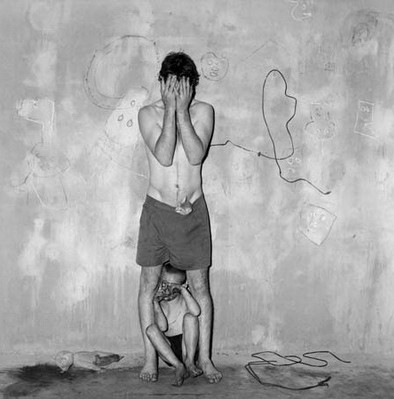Roger Ballen
05 Jan - 06 Feb 2010

© Roger Ballen
CONCEALED, 2003
Photographie noir et blanc
Courtesy : the artist and kamel mennour, Paris
CONCEALED, 2003
Photographie noir et blanc
Courtesy : the artist and kamel mennour, Paris
ROGER BALLEN
“Boarding House”
5 january - 6 february 2010
Kamel Mennour is pleased to present Boa rding House, Roger Ballen’s third solo photographic exhibition at the gallery.
On the outskirts of Johannesburg (South Africa) exists a warehouse built for the goldmines at the turn of the last century. The building, insalubrious and overcrowded, (a micro-neighbourhood), where a population of unemployed, criminals on the run, witch doctors, swarming with rodents and insects. Impoverished and inaccessible, “Boarding House” is the name given by the artist to this ephemeral residence, this dark and mystical “refuge” apparently haunted by demons.
For the past five years, Roger Ballen has photographed in this strange and unique place. Within this building, benches, blankets and sheets of metal demarcate each person’s space. Curious and worn-out objects, bits of dried vegetation, inside-out cardboard boxes, and twisted wire coat hangers litter the floors and walls and accentuate surfaces already covered with naive graffiti and expressive children’s drawings.
Compared to Ballen’s previous series, human figures do not predominate. Only a few fragments of bodies – hands and limbs – feature in the artist’s sculptural, sophisticated compositions. Lacking vanishing points, they display a veritable saturation of signs and symbols that create a host of complex metaphors.
Within the boundaries of the square format, Roger Ballen deploys a methodology of resonances and interdependencies between objects, juxtaposition of angles and strata: manipulating, rearranging and restructuring with the aim of revealing our hidden face, our underlying animal-like persona.
Ballen’s Boa rding House is intriguing, melancholic and brutal. His photographs push us to the edge of reality and force us to introspect the nature of ourselves.
Between tragedy and comedy, Roger Ballen brings us a sombre universe not far from those depicted by Samuel Beckett, Antonin Arnaud, Francis Bacon and Jean Dubuffet.
The Boa rding House series has been the subject of a recent publication from Phaïdon.
A geologist by training and a graduate of University California Berkley, born in New York in 1950, Roger Ballen has lived and worked in Johannesburg (South Africa) for more than 30 years, during this time publishing eight photographic books.
His work has been shown at numerous group and solo exhibitions throughout the world including : the Deichtorhallen in Hamburg (Germany), the Stedelijk Museum in Amsterdam (Holland), the Museum of Contemporary Art in San Diego (USA), and the Bibliothèque Nationale de France in Paris.
His work is also represented in numerous collections such as those of MoMA and the Brooklyn Museum in New York, the County Museum of Arts in Los Angeles, the Museum of Contemporary Arts in San Diego, the Victoria & Albert Museum in London, the Stejelijk Museum in Amsterdam, the Fonds National d'Art Contemporain, the Centre Pompidou, as well as the Maison Européenne de la Photographie in Paris.
“Boarding House”
5 january - 6 february 2010
Kamel Mennour is pleased to present Boa rding House, Roger Ballen’s third solo photographic exhibition at the gallery.
On the outskirts of Johannesburg (South Africa) exists a warehouse built for the goldmines at the turn of the last century. The building, insalubrious and overcrowded, (a micro-neighbourhood), where a population of unemployed, criminals on the run, witch doctors, swarming with rodents and insects. Impoverished and inaccessible, “Boarding House” is the name given by the artist to this ephemeral residence, this dark and mystical “refuge” apparently haunted by demons.
For the past five years, Roger Ballen has photographed in this strange and unique place. Within this building, benches, blankets and sheets of metal demarcate each person’s space. Curious and worn-out objects, bits of dried vegetation, inside-out cardboard boxes, and twisted wire coat hangers litter the floors and walls and accentuate surfaces already covered with naive graffiti and expressive children’s drawings.
Compared to Ballen’s previous series, human figures do not predominate. Only a few fragments of bodies – hands and limbs – feature in the artist’s sculptural, sophisticated compositions. Lacking vanishing points, they display a veritable saturation of signs and symbols that create a host of complex metaphors.
Within the boundaries of the square format, Roger Ballen deploys a methodology of resonances and interdependencies between objects, juxtaposition of angles and strata: manipulating, rearranging and restructuring with the aim of revealing our hidden face, our underlying animal-like persona.
Ballen’s Boa rding House is intriguing, melancholic and brutal. His photographs push us to the edge of reality and force us to introspect the nature of ourselves.
Between tragedy and comedy, Roger Ballen brings us a sombre universe not far from those depicted by Samuel Beckett, Antonin Arnaud, Francis Bacon and Jean Dubuffet.
The Boa rding House series has been the subject of a recent publication from Phaïdon.
A geologist by training and a graduate of University California Berkley, born in New York in 1950, Roger Ballen has lived and worked in Johannesburg (South Africa) for more than 30 years, during this time publishing eight photographic books.
His work has been shown at numerous group and solo exhibitions throughout the world including : the Deichtorhallen in Hamburg (Germany), the Stedelijk Museum in Amsterdam (Holland), the Museum of Contemporary Art in San Diego (USA), and the Bibliothèque Nationale de France in Paris.
His work is also represented in numerous collections such as those of MoMA and the Brooklyn Museum in New York, the County Museum of Arts in Los Angeles, the Museum of Contemporary Arts in San Diego, the Victoria & Albert Museum in London, the Stejelijk Museum in Amsterdam, the Fonds National d'Art Contemporain, the Centre Pompidou, as well as the Maison Européenne de la Photographie in Paris.
